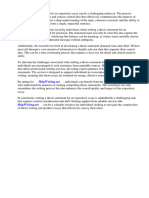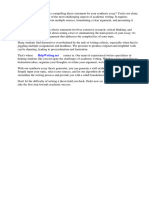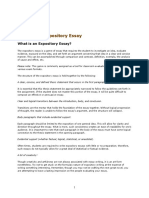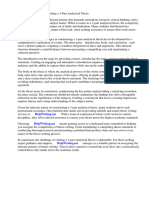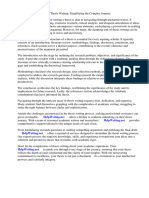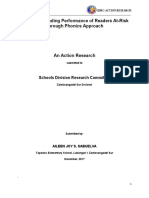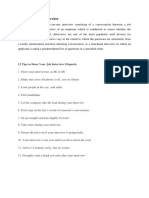0 ratings0% found this document useful (0 votes)
292 viewsExpository Essays: What Is An Expository Essay?
Expository Essays: What Is An Expository Essay?
Uploaded by
YelleAn expository essay requires investigating an idea, evaluating evidence, and setting forth an argument about that idea in a clear manner. It must have a thesis statement in the first paragraph, logical transitions between sections, body paragraphs supporting the thesis with evidence, and a conclusion that readdresses the thesis without introducing new information. A common structure is a five-paragraph essay with an introduction, three body paragraphs, and a conclusion. Methods to develop and organize expository essays include definition, description, chronological sequence, classification, comparison, and identifying causes and effects.
Copyright:
© All Rights Reserved
Available Formats
Download as DOCX, PDF, TXT or read online from Scribd
Expository Essays: What Is An Expository Essay?
Expository Essays: What Is An Expository Essay?
Uploaded by
Yelle0 ratings0% found this document useful (0 votes)
292 views4 pagesAn expository essay requires investigating an idea, evaluating evidence, and setting forth an argument about that idea in a clear manner. It must have a thesis statement in the first paragraph, logical transitions between sections, body paragraphs supporting the thesis with evidence, and a conclusion that readdresses the thesis without introducing new information. A common structure is a five-paragraph essay with an introduction, three body paragraphs, and a conclusion. Methods to develop and organize expository essays include definition, description, chronological sequence, classification, comparison, and identifying causes and effects.
Original Description:
Expository Essay
Original Title
Expository Essay
Copyright
© © All Rights Reserved
Available Formats
DOCX, PDF, TXT or read online from Scribd
Share this document
Did you find this document useful?
Is this content inappropriate?
An expository essay requires investigating an idea, evaluating evidence, and setting forth an argument about that idea in a clear manner. It must have a thesis statement in the first paragraph, logical transitions between sections, body paragraphs supporting the thesis with evidence, and a conclusion that readdresses the thesis without introducing new information. A common structure is a five-paragraph essay with an introduction, three body paragraphs, and a conclusion. Methods to develop and organize expository essays include definition, description, chronological sequence, classification, comparison, and identifying causes and effects.
Copyright:
© All Rights Reserved
Available Formats
Download as DOCX, PDF, TXT or read online from Scribd
Download as docx, pdf, or txt
0 ratings0% found this document useful (0 votes)
292 views4 pagesExpository Essays: What Is An Expository Essay?
Expository Essays: What Is An Expository Essay?
Uploaded by
YelleAn expository essay requires investigating an idea, evaluating evidence, and setting forth an argument about that idea in a clear manner. It must have a thesis statement in the first paragraph, logical transitions between sections, body paragraphs supporting the thesis with evidence, and a conclusion that readdresses the thesis without introducing new information. A common structure is a five-paragraph essay with an introduction, three body paragraphs, and a conclusion. Methods to develop and organize expository essays include definition, description, chronological sequence, classification, comparison, and identifying causes and effects.
Copyright:
© All Rights Reserved
Available Formats
Download as DOCX, PDF, TXT or read online from Scribd
Download as docx, pdf, or txt
You are on page 1of 4
Expository Essays
What is an expository essay?
The expository essay is a genre of essay that requires the student to investigate an idea, evaluate evidence, expound on the idea, and set forth an argument concerning that idea in a
clear and concise manner. This can be accomplished through comparison and contrast, definition, example, the analysis of cause and effect, etc.
Please note: This genre is commonly assigned as a tool for classroom evaluation and is often found in various exam formats.
The structure of the expository essay is held together by the following.
A clear, concise, and defined thesis statement that occurs in the first paragraph of the essay.
o It is essential that this thesis statement be appropriately narrowed to follow the guidelines set forth in the assignment. If the student does not master this portion of
the essay, it will be quite difficult to compose an effective or persuasive essay.
Clear and logical transitions between the introduction, body, and conclusion.
o Transitions are the mortar that holds the foundation of the essay together. Without logical progression of thought, the reader is unable to follow the essays
argument, and the structure will collapse.
Body paragraphs that include evidential support.
o Each paragraph should be limited to the exposition of one general idea. This will allow for clarity and direction throughout the essay. What is more, such
conciseness creates an ease of readability for ones audience. It is important to note that each paragraph in the body of the essay must have some logical
connection to the thesis statement in the opening paragraph.
Evidential support (whether factual, logical, statistical, or anecdotal).
o Often times, students are required to write expository essays with little or no preparation; therefore, such essays do not typically allow for a great deal of statistical
or factual evidence.
A bit of creativity!
o Though creativity and artfulness are not always associated with essay writing, it is an art form nonetheless. Try not to get stuck on the formulaic nature of
expository writing at the expense of writing something interesting. Remember, though you may not be crafting the next great novel, you are attempting to leave a
lasting impression on the people evaluating your essay.
A conclusion that does not simply restate the thesis, but readdresses it in light of the evidence provided.
o It is at this point of the essay that students will inevitably begin to struggle. This is the portion of the essay that will leave the most immediate impression on the
mind of the reader. Therefore, it must be effective and logical. Do not introduce any new information into the conclusion; rather, synthesize and come to a
conclusion concerning the information presented in the body of the essay.
A complete argument
Perhaps it is helpful to think of an essay in terms of a conversation or debate with a classmate. If I were to discuss the cause of the Great Depression and its current effect on those
who lived through the tumultuous time, there would be a beginning, middle, and end to the conversation. In fact, if I were to end the exposition in the middle of my second point,
questions would arise concerning the current effects on those who lived through the Depression. Therefore, the expository essay must be complete, and logically so, leaving no doubt
as to its intent or argument.
The five-paragraph Essay
A common method for writing an expository essay is the five-paragraph approach. This is, however, by no means the only formula for writing such essays. If it sounds straightforward,
that is because it is; in fact, the method consists of:
1. an introductory paragraph
2. three evidentiary body paragraphs
3. a conclusion
Methods of Development in Expository Writing
Methods of Development
Expository writing - the purpose of the author is to inform, explain, describe, or define his or her subject to the reader. Expository text is meant to
expose information and is the most frequently used type of writing by students in colleges and universities. A well-written exposition remains
focused on its topic and provides facts in order to inform its reader. It is written from the third person point of view.
Examples of expository writing can be found in magazine and newspaper articles, non-fiction books, travel brochures, business reports,
memorandums, professional journal and encyclopedia articles and many other types of informative writing. One of the most familiar and basic
forms of expository writing is the five-paragraph essay, which features an introduction with a clear thesis statement, three main body paragraphs
and a conclusion.
Methods of Organization:
Definition - Defining topics and subjects is particularly important in expository writing. Defining an object is, simply, stating what the particular
object is.
Description - Writing which intends to describe a person, place or thing is known as descriptive writing and is a form of expository writing.
Description involves giving characteristics- such as how something appears, smells or the dimensions of an object.
Sequence - This structure is also known as process or collection and is a form of expository writing that is used if the author intends to inform his
or her readers by listing the order of steps in a process or listing events in chronological order. Examples of this type of writing are cooking
instructions, driving directions and instructions on performing a task. Key words such as first, after, next, then and last usually signal sequential
writing.
Classification - is an organizational strategy in which authors arrange groups of objects or ideas according to a common topic in detail. Placing
different objects or ideas in categories is a type of classification.
Comparison - Comparative text shows how two or more subjects are similar or contrasting. This type of structure is often used in determining
which is the better of two or more choices.
Cause and effect - Cause and effect writing identifies the reason for something occurring and lists what occurs because of that reason. This is
also known as analysis text.
Sources:
https://owl.english.purdue.edu/owl/resource/685/02/
https://sites.google.com/a/cloud.ocdsb.ca/inawhiteroomeng3u/essay-writing-skills-and-support/methods-of-development-in-expository-writing
You might also like
- Expository Writing BookDocument89 pagesExpository Writing BookYasir Abbas100% (4)
- Noise Assessment Procedure GEK110392aDocument6 pagesNoise Assessment Procedure GEK110392a1amonet2No ratings yet
- LSD - Mein Sorgenkind by Albert Hofmann (German Original)Document3 pagesLSD - Mein Sorgenkind by Albert Hofmann (German Original)ms_sucks7423No ratings yet
- Essays A CollectionDocument235 pagesEssays A Collectionanis_mansourNo ratings yet
- Essay WritingDocument2 pagesEssay WritingcgarmonrNo ratings yet
- Expository EssayDocument2 pagesExpository Essayelaiza maeNo ratings yet
- Tips On Writing An Expository Essay: Tel: 04-3996601 SMK Seberang JayaDocument5 pagesTips On Writing An Expository Essay: Tel: 04-3996601 SMK Seberang JayaTan Yean YeanNo ratings yet
- Essay TypesDocument5 pagesEssay TypesAyesha AshfaqNo ratings yet
- How-Can-You-Define-Writing-For-Global-Communication 1234Document10 pagesHow-Can-You-Define-Writing-For-Global-Communication 1234Angela NeriNo ratings yet
- Essay On Man) - While Brevity Usually Defines AnDocument3 pagesEssay On Man) - While Brevity Usually Defines AnHerwin Sayse BaldagoNo ratings yet
- Composition I Descreption and Narration Writing GrammarDocument210 pagesComposition I Descreption and Narration Writing Grammarmouhdda2024No ratings yet
- How To Write A Good Expository ThesisDocument4 pagesHow To Write A Good Expository Thesisnlcnqrgld100% (1)
- How To Write An Expository Essay Thesis StatementDocument4 pagesHow To Write An Expository Essay Thesis Statementafkngwetd100% (1)
- Expository TextDocument4 pagesExpository TextZulBachrakNo ratings yet
- Types of EssaysDocument98 pagesTypes of EssaysTamuna NatroshviliNo ratings yet
- Argumentative EssayDocument21 pagesArgumentative EssayTamuna NatroshviliNo ratings yet
- Informative-WritingDocument2 pagesInformative-WritingDeth San LorenzoNo ratings yet
- Thesis Statement For Thematic EssayDocument4 pagesThesis Statement For Thematic Essaybriannajohnsonwilmington100% (2)
- Expository WritingDocument4 pagesExpository WritingahtashamaleNo ratings yet
- EssayDocument3 pagesEssayReuben Justin M. VittoNo ratings yet
- Thesis in An Analytical EssayDocument8 pagesThesis in An Analytical EssayAshley Smith100% (1)
- Module 12Document3 pagesModule 12Jerome BautistaNo ratings yet
- Purdue OWLDocument9 pagesPurdue OWLMarcelo Andrade SantiagoNo ratings yet
- PPP P PPP PP PDocument4 pagesPPP P PPP PP PJefferson Garcia BalotNo ratings yet
- Thesis Example Analytical EssayDocument4 pagesThesis Example Analytical EssayCustomPaperWritingServicesUK100% (3)
- Expository Vs ArgumentativeDocument10 pagesExpository Vs ArgumentativelearningselfNo ratings yet
- Summary Chapter 7 (Azzahra Natasya)Document7 pagesSummary Chapter 7 (Azzahra Natasya)Azzahra NatasyaNo ratings yet
- Example of Literature Thesis StatementDocument6 pagesExample of Literature Thesis StatementFiona Phillips100% (1)
- Types of Essays PDFDocument6 pagesTypes of Essays PDFOmar Jean Piaget BorperNo ratings yet
- Writing A Good Essay Thesis StatementDocument6 pagesWriting A Good Essay Thesis Statementerinmooreeverett100% (2)
- Argumentative EssaysDocument6 pagesArgumentative EssaysMaDF100% (1)
- Expository Thesis Statement PowerpointDocument8 pagesExpository Thesis Statement Powerpointjillcrawfordbaltimore100% (2)
- BCP - BCH Essay Writing PDFDocument4 pagesBCP - BCH Essay Writing PDFPALLAVI pallavi2No ratings yet
- Q3 Week1 EappDocument4 pagesQ3 Week1 EappLyka Christine AlbinaNo ratings yet
- Research Methods NotesDocument14 pagesResearch Methods Notesdammydave4No ratings yet
- Essay Writing TipsDocument9 pagesEssay Writing TipsctlbNo ratings yet
- A Paragraph Is A Group of Related Sentences That Support One Main IdeaDocument12 pagesA Paragraph Is A Group of Related Sentences That Support One Main IdeaJustine Joi GuiabNo ratings yet
- Intro to EWDocument8 pagesIntro to EWwaizowlkhanNo ratings yet
- Paper GuidelinesDocument8 pagesPaper Guidelinesapi-141156084No ratings yet
- Expository EssaysDocument4 pagesExpository EssaysAndreNo ratings yet
- Eapp 1ST Quarter NotesDocument6 pagesEapp 1ST Quarter Notesanaira wahab100% (1)
- How To Write A Three-Part Analytical ThesisDocument7 pagesHow To Write A Three-Part Analytical ThesisWriteMyStatisticsPaperUK100% (2)
- Notes Essay WritingDocument10 pagesNotes Essay WritingBhavuk BansalNo ratings yet
- EssayDocument2 pagesEssayJasmine Kyle LutherNo ratings yet
- What Is An Essay?Document7 pagesWhat Is An Essay?Arsh SyedNo ratings yet
- How To Write A Thesis Statement For Expository EssayDocument5 pagesHow To Write A Thesis Statement For Expository Essayubkciwwff100% (1)
- How To Write An Expository Essay - A Step-By-Step GuideDocument3 pagesHow To Write An Expository Essay - A Step-By-Step GuideZain KhalidNo ratings yet
- Midterm CoverageDocument5 pagesMidterm Coveragejamesd.pasion14No ratings yet
- EW Updated S1Document4 pagesEW Updated S1azharalikhan1810No ratings yet
- Main Thesis StatementDocument8 pagesMain Thesis Statementshellymartinezbuffalo100% (2)
- Synthesis Essay Thesis GeneratorDocument6 pagesSynthesis Essay Thesis Generatorrachellelewiskansascity100% (1)
- The Expository EssayDocument4 pagesThe Expository Essayantonia100No ratings yet
- What Is A Thesis Sentence ExampleDocument4 pagesWhat Is A Thesis Sentence Examplemitzilarrickakron100% (1)
- EsssayDocument5 pagesEsssayNuman FarooqiNo ratings yet
- What Is The Length of A Typical Thesis StatementDocument8 pagesWhat Is The Length of A Typical Thesis Statementtiffanysurrattlittlerock100% (2)
- 3 Part Analytical ThesisDocument8 pages3 Part Analytical Thesisokxyghxff100% (2)
- Thesis Statement Definition ExamplesDocument8 pagesThesis Statement Definition ExamplesDoMyPaperForMoneyUK100% (2)
- Generic Structure Thesis Argument RecommendationDocument6 pagesGeneric Structure Thesis Argument Recommendationheduurief100% (1)
- Analytical WritingDocument4 pagesAnalytical Writingcellestial_knightNo ratings yet
- What Is An EssayDocument2 pagesWhat Is An EssayJose Ibañez100% (1)
- Annotation, Review, EssaysDocument6 pagesAnnotation, Review, EssaysDilnaz MuzaparovaNo ratings yet
- Understanding Essay Writing: A Guide To Writing Essays By Someone Who Grades ThemFrom EverandUnderstanding Essay Writing: A Guide To Writing Essays By Someone Who Grades ThemRating: 4 out of 5 stars4/5 (4)
- Ennai MulukuDocument2 pagesEnnai MulukukandeepanNo ratings yet
- It 318 - Capstone Project and Research 1 - Course OutlineDocument2 pagesIt 318 - Capstone Project and Research 1 - Course OutlineMJ TimoganNo ratings yet
- Discharge Screw Conveyors Design SelectionDocument5 pagesDischarge Screw Conveyors Design SelectionHadid100% (1)
- Noteworthy Characteristics For The MSPEDocument2 pagesNoteworthy Characteristics For The MSPEBailey B.No ratings yet
- Improving Reading Performance of Readers At-Risk Through Phonics ApproachDocument10 pagesImproving Reading Performance of Readers At-Risk Through Phonics ApproachAILEEN JOY SabuelvaNo ratings yet
- Jakson Power Solutions Is A Diversified Business Group With Multiple InterestsDocument86 pagesJakson Power Solutions Is A Diversified Business Group With Multiple InterestsSatyajeet AsthanaNo ratings yet
- Edad 310Document4 pagesEdad 310Lubeth Cabatu0% (1)
- Health Management Plan DR Ajeh 610Document29 pagesHealth Management Plan DR Ajeh 610chelseapasiahNo ratings yet
- Sieving For Perfect Quality Control: MillingDocument12 pagesSieving For Perfect Quality Control: MillingAndri FitriyadiNo ratings yet
- Political Science Notes 2Document56 pagesPolitical Science Notes 2Shamshad Ali RahoojoNo ratings yet
- Time Management in IELTS ReadingDocument12 pagesTime Management in IELTS ReadingNguyễn Hoài Anh Thư100% (1)
- 5e47fb405761f Cronus Imt Ghaziabad Round2Document7 pages5e47fb405761f Cronus Imt Ghaziabad Round2NarenderNo ratings yet
- English-10-Las Deped 4TH QuarterDocument14 pagesEnglish-10-Las Deped 4TH Quarterroleplayacc2008No ratings yet
- Mycareer Development Portfolio Template and ScoringDocument15 pagesMycareer Development Portfolio Template and ScoringneviNo ratings yet
- Human Trafficking Health Research Progress and Future DirectionsDocument5 pagesHuman Trafficking Health Research Progress and Future DirectionsIan AdarveNo ratings yet
- Defining A Lowest-Risk UAS CategoryDocument26 pagesDefining A Lowest-Risk UAS CategoryApril GlaserNo ratings yet
- Regression Analysis Final-ExamDocument8 pagesRegression Analysis Final-Examjanice m. gasparNo ratings yet
- Dataset Amusement ParkDocument21 pagesDataset Amusement Parkvedant.sharma.csNo ratings yet
- Supply Chain Mapping For The Forest Products Industry - HaartvDocument30 pagesSupply Chain Mapping For The Forest Products Industry - HaartvTharun SebastianNo ratings yet
- XDocument15 pagesXI'm DekuuNo ratings yet
- Definition of Job InterviewDocument8 pagesDefinition of Job InterviewSonia WImarselaNo ratings yet
- Laurencia C Wibawa ResumeDocument1 pageLaurencia C Wibawa ResumeLaurencia Chrisyanti WibawaNo ratings yet
- Term Paper in BDDocument5 pagesTerm Paper in BDc5qj4swh100% (1)
- Project Management in RDDocument25 pagesProject Management in RDRahul Jain100% (1)
- Construction Management ProjectDocument11 pagesConstruction Management ProjectVaibhav PatilNo ratings yet
- The Business CaseDocument2 pagesThe Business CasekuttivasanthNo ratings yet
- Trends, Networks, and Critical Thinking First QuarterDocument7 pagesTrends, Networks, and Critical Thinking First QuarterCho Co100% (2)













































